Related Research Articles

Hallamshire is the historical name for an area of South Yorkshire, England, approximating to the current City of Sheffield local government area.

Ecclesall Ward—which includes the neighbourhoods of Banner Cross, Bents Green, Carterknowle, Ecclesall, Greystones, Millhouses, and Ringinglow—is one of the 28 electoral wards in City of Sheffield, England. It is located in the southwestern part of the city and covers an area of 3.6 square miles. The population of this ward in 2007 was 19,211 people in 7,626 households, reducing to 6,657 at the 2011 Census. Ecclesall ward is one of the four wards that make up the South West Community Assembly and one of five wards that make up the Sheffield Hallam Parliamentary constituency. The Member of Parliament is Olivia Blake, a Labour MP. Ecclesall is one of the least socially deprived wards in the entire country, with a 2002 deprivation score of 4.7—making it the 8,105th most deprived ward out of 8,414 wards in the country. The demographic consists largely of white, middle-class families.
Handsworth is a suburb of south eastern Sheffield, in South Yorkshire, England. It covers an area of approximately 5 square miles (13 km2), and has a population of approximately 15,000. It has five schools, four churches, a variety of small shops, a large supermarket, and a range of commercial and light industrial businesses. The area is signposted from M1 Junction 31.

The Dragon of Wantley is a legend of a dragon-slaying by a knight on Wharncliffe Crags in South Yorkshire, recounted in a comic broadside ballad of 1685, later included in Thomas Percy's 1767 Reliques of Ancient English Poetry, and enjoying widespread popularity in the 18th and 19th centuries, although less well-known today. The ballad tells of how a huge dragon - almost as big as the Trojan Horse - devours anything it wishes, even trees and buildings, until the Falstaffian knight Moore of Moore Hall obtains a bespoke suit of spiked Sheffield armour and delivers a fatal kick to the dragon's "arse-gut" - its only vulnerable spot, as the dragon explains with its dying breath. The topography of the ballad is accurate in its detail as regards Wharncliffe Crags and environs, but the story, and its burlesque humour, has been enjoyed in places far from the landscape from which it appears to derive and has been used to make a number of points unrelated to it.
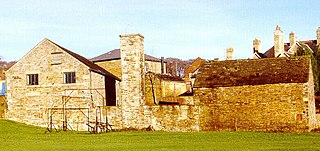
Millhouses is a neighbourhood in the City of Sheffield, England. It is located in Ecclesall ward; in the south-western portion of the city on the northwest bank of the River Sheaf. Its origins lie in a small hamlet that grew around the Ecclesall Corn Mill. It has a population of 4,424.

Whirlow is a suburb of the City of Sheffield in England, it lies 3.7 miles (6 km) south-west of the city centre. The suburb falls within the Dore and Totley ward of the City. It is one of the most affluent areas of Sheffield, with much high class housing and several notable small country houses within it. During the Victorian era it was home to some of Sheffield's most influential citizens. Whirlow straddles the A625, the main Sheffield to Hathersage road. The suburb covers the area from Parkhead in the north to Whirlow Bridge in the south and from Ecclesall Woods in the east to Broad Elms Lane in the west. Whirlow had a population of 1,663 in 2011.
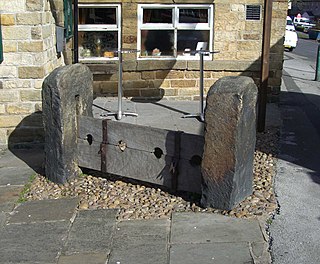
Wadsley is a suburb of the City of Sheffield in South Yorkshire, England. It stands 3 miles (5 km) north-west of the city centre at an approximate grid reference of SK321905. At the 2011 Census the suburb fell within the Hillsborough ward of the City. Wadsley was formerly a rural village which was engulfed by the expansion of Sheffield in the early part of the 20th century.
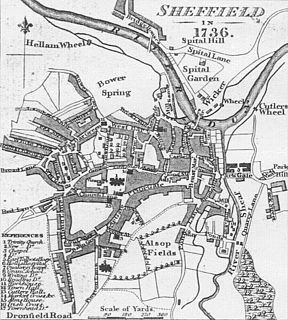
The history of Sheffield, a city in South Yorkshire, England, can be traced back to the founding of a settlement in a clearing beside the River Sheaf in the second half of the 1st millennium AD. The area now known as Sheffield had seen human occupation since at least the last ice age, but significant growth in the settlements that are now incorporated into the city did not occur until the Industrial Revolution.

Joseph Hunter was a Unitarian Minister, antiquarian, and deputy keeper of public records now best known for his publications Hallamshire. The History and Topography of the Parish of Sheffield in the County of York, the two-volume South Yorkshire , still considered among the best works written on the history of Sheffield and South Yorkshire, and his 1852 pamphlet on Robin Hood in which he argued that a servant of this name at the court of Edward II was identical with the famous outlaw. His name was adopted by the Hunter Archaeological Society.
Hallamshire was a Parliamentary constituency covering the Hallamshire district of England. The constituency was created in 1885 and abolished in 1918. The seat was a large geographical area which in the west included the moors of the Pennines, but came down from the hills in the centre to include better farmland north of Sheffield around Ecclesfield. In the north-east it included part of the South Yorkshire coalfield and some mining villages. In the south, the residents of Sheffield who owned their freeholds could vote in this division.
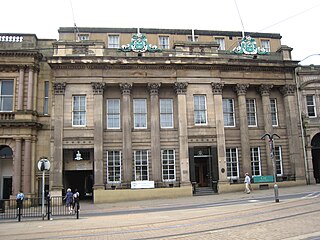
Cutlers' Hall is a Grade II* listed building in Sheffield, England, that is the headquarters of the Company of Cutlers in Hallamshire. It is located on Church Street, opposite Sheffield Cathedral, in Sheffield City Centre.
The Master Cutler is the head of the Company of Cutlers in Hallamshire established in 1624. Their role is to act as an ambassador of industry in Sheffield, England. The Master Cutler is elected by the freemen of the company on the first Monday of September of each year and the position taken in the first Tuesday of October. Despite the title, the Master Cutler does not have to be involved in the cutlery business, or even the steel industry, to be elected.
This timeline of Sheffield history summarises key events in the history of Sheffield, a city in England. The origins of the city can be traced back to the founding of a settlement in a clearing beside the River Sheaf in the second half of the 1st millennium AD. The area had seen human occupation since at least the last ice age, but significant growth in the settlements that are now incorporated into the city did not occur until the industrial revolution.
The Sheffield Industrial Museums Trust (SIMT) is an independent charitable trust based in Sheffield, England, that runs the Sheffield City Council-owned Kelham Island, Abbeydale Industrial Hamlet, and Shepherd Wheel museums.

Church Street is situated in the centre of Sheffield, South Yorkshire, England, at the grid reference of SK353874. It runs for approximately 490 yards (450 m) in a westerly direction from its junction with Fargate and High Street to its termination at the crossroads formed by the junction with West Street, Leopold Street and Townhead Street. Church Street has its own Sheffield Supertram stop directly in front of the Sheffield Cathedral and it carries that name.
The Sheffield Improvement Act 1818 is an Act of Parliament passed in 1818 regarding the administration of the town of Sheffield in the West Riding of Yorkshire.
The Church Burgesses, formerly known officially as the Twelve Capital Burgesses and Commonalty of the Town and Parish of Sheffield, are a charitable organisation in the city of Sheffield in South Yorkshire.
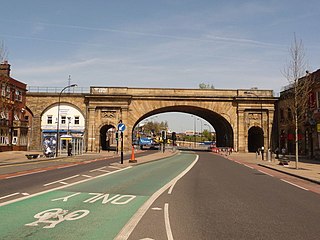
The Wicker is an arterial street in Sheffield, England noted for its history and viaduct that crosses it, the Grade II* listed Wicker Arches. It runs in a north-east to south-westerly direction between Lady's Bridge and the Wicker Arches. For many years the Wicker was an A road, but it has been downgraded following the opening of the Sheffield Northern Relief Road.

Ughill is a small, rural hamlet within the City of Sheffield in Bradfield Parish in England. It is 5 mi west-northwest of the city centre. It stands in a lofty position at 918 ft above sea level, on a ridge between Bradfield Dale and the valley of the Ughill Brook. It has traditionally been a farming community, but there was some mining in the area in the late 19th and 20th century. Ughill Hall was the scene of an infamous murder in September 1986. The hamlet falls within the Stannington ward of the City.
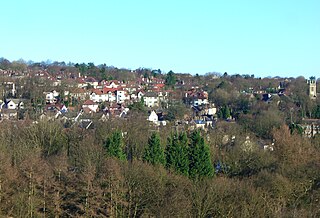
Fulwood is a residential suburb and ward of the City of Sheffield in England, it lies 5.5 km west-southwest of the city centre. Formerly an ancient settlement and village on the Porter Brook, it became integrated into the city in the 1930s. It is bounded by the suburbs of Lodge Moor to the NW, Ranmoor to the east and Crosspool to the NE. The open countryside of the Peak District lies to the west and SW. The sub districts of Stumperlowe and Goole Green are part of the suburb. The population of the ward at the 2011 Census was 18,233. Fulwood is located in the Sheffield Hallam constituency which, as of the 2019 general election voted Labour.
References
- 1 2 Robert Tittler, The Reformation and the Towns in England
- 1 2 3 4 5 6 7 8 Clyde Binfield et al., The History of the City of Sheffield 1843-1993: Volume I: Politics
- 1 2 Sidney and Beatrice Webb, The Manor and the Borough
- 1 2 Clyde Binfield and David Hey, Mesters to Masters: A History of the Company of Cutlers in Hallamshire
- ↑ Edward Baines, History, Directory & Gazetteer, of the County of York: Vol I - West Riding
- ↑ Sidney Oldall Addy, Church and Manor: A Study in English Economic History
- ↑ William White, History & General Directory of the Borough of Sheffield (1833)
- ↑ The CROOKES MOOR RACES - SHEFFIELD (c1713-1785)
- ↑ Sheffield's Coat of Arms Archived 2008-04-01 at the Wayback Machine , Sheffield City Council
- ↑ SHEFFIELD TOWN TRUST, THE Archived 2011-08-14 at the Wayback Machine , Help Yourself Database
- ↑ Cathedral Quarter Action Plan, Sheffield City Council
- ↑ Sheffield Town Trust Archived 2008-01-31 at the Wayback Machine , Sheffield Botanical Gardens
- ↑ "Solicitors, Law Firm, Injury Lawyers, Leeds, Sheffield, Doncaster". www.keebles.com. Retrieved 12 December 2019.
{{cite web}}: CS1 maint: url-status (link) - ↑ "George Connell". www.keebles.com. Retrieved 12 December 2019.
{{cite web}}: CS1 maint: url-status (link) - ↑ Postgraduate Scholarships and Studentships Archived 2008-09-24 at the Wayback Machine , University of Sheffield
- ↑ Rodney Sharp, "OBITUARY: PROFESSOR DOUGLAS NORTHCOTT", The Independent , 2 May 2005
- ↑ The Statutes of the University Archived 2006-04-05 at the Wayback Machine , University of Sheffield